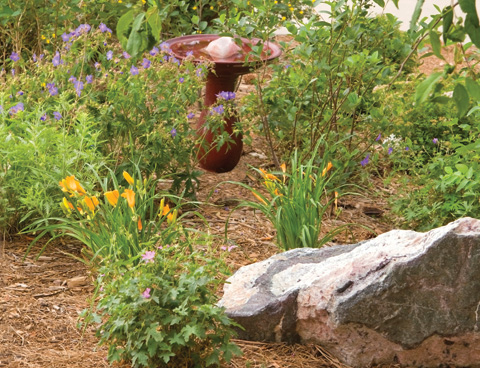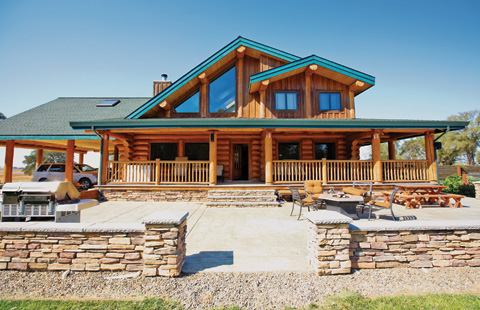This issue’s theme is legacy log homes—building a log home now that will be passed down to future generations. It makes sense to build the best possible log home using the highest quality of materials that will withstand all weather conditions, pests, and other natural elements. It also makes sense to build a log home that is energy and water efficient. Energy costs are on the rise now and there’s no telling how high they will go in the future. Water, a most precious resource, is also worth conserving through efficient use. And, preserving the beauty, natural habitats of animals and plants, and air quality surrounding your log home are of primary concern.
There are many rating systems that can help you reach your green-building goals, including Energy Star (which we covered in the July issue) as well as many state and regional programs. For those who are committed to building the best possible green home and have the resources to accomplish that, LEED sets the gold standard for home rating systems. A home certified LEED Gold or Platinum would score at the top of any of the other home rating systems.
LEED (Leadership in Energy and Environmental Design) was launched by the U.S. Green Building Council (USGBC) in 2000 as a voluntary rating system for public and commercial buildings. In 2005, the USGBC developed LEED-H for private homes, including condos, apartments, townhouses, and single-family homes. Since LEED-H was established, over 10,000 homes have been certified. USGBS inspects, tests, and approves every home built under the LEED program. According to the USGBC, “LEED for Homes is a consensus-developed, third-party verified rating system that provides a basis for quantifying the benefits of green homes.”
The LEED Rating System
Every home is rated in eight credit categories: (1) Innovation and Design, (2) Location and Linkages, (3) Sustainable Sites, (4) Water Efficiency, (5) Energy and Atmosphere, (6) Materials and Resources, (7) Indoor Environmental Quality, (8) Awareness and Education. A home can earn a maximum of 136 points over the eight categories and receive a certification based on the number of verified points. Certified requires 45-59 points; Silver, 60-74; Gold, 75-89, and Platinum, 90-136. The number of points varies by category, and some of the categories have prerequisites. Three of the categories offer a choice of paths; if one path does not work with your property or home, there are options to choose from. The descriptions here are just an overview; for more comprehensive information visit the USGBC website: www.usgbc.org.
Location and Linkages (10 possible points). This category addresses the building site and its impact on the environment. Ideally, the site should need few infrastructure elements such as roads and water and sewer lines. There should be opportunities to reduce dependence on cars by using public transportation, walking, or bicycling. Choosing a site near services and retail outlets also reduces the need for driving. Access to protected open space is also one of the requirements. A home can earn the full 10 points by following the first path: LEED for Neighborhood Development. For log homes, which are not usually in neighborhoods, the second path breaks the requirements down into individual credits.
Innovation and Design Process (11 possible points). The two prerequisites in this section require a preliminary rating of the home design and durability planning and management. Points are earned for coordinating and integrating the various elements that go into a green, LEED-certified home. The builder, or project leader, must have LEED for Homes credentials. Orienting the home for solar energy use is also rewarded in this category. The most points in this category are awarded for innovative or regional design that leads to quantifiable environmental and human health benefits.
Sustainable Sites (22 possible points; 5 points required). Points are rewarded in this category based on how little impact the building site has on the environment. There are two prerequisites: controlling erosion during construction and landscaping using no invasive plants. Points are given for minimal use of conventional grass, which requires irrigation and treatment for weeds and pests. (Two points are given for using nontoxic pest control.) Instead, native and drought-tolerant plants will reduce the overall irrigation demand by at least 20 percent. This category also addresses surface water management by creating a permeable lot, putting permanent erosion control in place, and managing water run-off from the roof. It promotes the use of bioswales, retention ponds, and other methods of absorbing stormwater runoff and renewing groundwater basins.
Water Efficiency (15 possible points; 3 points required). Earning credits in this category can reduce water usage by 30 percent or more. Up to five points are awarded for reusing water by collecting rainwater, recycling gray water from the home, or using a municipal recycled water system. Points are also given for reducing overall irrigation demand by at least 45 percent. Indoors, the number of points earned depends on the efficiency of your fixtures and appliances.

Using native, drought resistant plants and natural rocks puts little stress on the exterior environment of a LEED-certified home. photo credit: iStock
Energy and Atmosphere (38 possible points). The goal of this category is to reduce home energy usage and carbon dioxide generation by creating an efficient building envelope, taking energy-saving measures in the home, and using alternative energy sources such as solar power. The two requirements are Energy Star for Homes performance and refrigerant management for both refrigerators and HVAC. Efficient hot water distribution and proper insulation of hot water pipes are rewarded with points. In this category, up to 34 points can be earned for exceptional energy performance; earning the top rating here would mean that you have a zero-net-energy home! The USGBC maintains that a LEED-certified home will use 30 to 40 percent less energy and prevent more than 100 metric tons of carbon dioxide emissions from entering the atmosphere over its lifetime.
Materials and Resources (16 possible points; 2 points required). There are three requirements in this category: limiting the framing order waste factor, using FSC-certified tropical wood, and planning for construction waste management. Harvesting or extracting, processing, transporting, and disposing of building materials are important considerations for a sustainable home. LEED also gives points for using environmentally preferable products such as reclaimed timber, recycled materials, locally sourced materials, third-party certified wood products, and low-VOC materials.
Indoor Environmental Air Quality (21 possible points; 6 points required). Indoor pollutants affect the millions of Americans who suffer from asthma and allergies, and some pollutants are known to cause diseases in otherwise healthy people. Indoor air quality begins with construction; points are awarded for keeping dust and other debris out of the home and thus out of the ventilation system. Many builders “flush out” the home before the owners move in. Also make sure the adhesives, paints, stains, floor coverings, and millwork are evaluated and products with low levels of VOCs are chosen. Using high-quality air filters will also help keep contaminants out of the home. Points are awarded for good ventilation, whereby fresh outdoor air is exchanged for polluted indoor air by a mechanical ventilation system. Proper ventilation will also help control the moisture level in the home. LEED will award up to 13 points if the home is built to Energy Star with Indoor Air Package standards.
Awareness and Education (3 possible points). This category awards points for educating homeowners about the systems in the home and how to run and maintain them. Before they move in homeowners should be presented with a detailed guide to their home and given a walk-through of all the building systems.
How to Get Started
As you see from the brief description of categories, building and operating a LEED-certified home requires a great deal of commitment on the part of all those involved in the project, from builder/contractors to carpenters to HVAC professionals to finishers, and, ultimately, the homeowners.
The first and most important step is to find a builder/contractor with extensive green building experience to manage all aspects of construction. According to USGBS, an experienced green builder may be able to build a LEED-rated home for as little as 1 percent of the total cost whereas the cost may increase to 4-5 percent with an inexperienced builder. You or your builder will need to find a LEED for Homes Provider that will be responsible for submitting plans, forms, and other paperwork to a panel of judges at the USGBC in Washington, D.C. Inspections are carried out by a LEED for Homes Green Rater under the guidance of the Homes Provider. Whether the Provider or Rater are individuals or companies, the have demonstrated expertise in green building.
Before you begin designing your home, decide what level of LEED certification you want to achieve and establish a budget. Consider challenging yourself and your team by aiming at a higher certification level that could lead to some creative, out-of-the-box thinking. Keep in mind that attaining the higher LEED certification levels will add to your overall cost. Once you have them, stick to your budget and green goals.
Is LEED Certification for You?
The “L” in LEED stands for leadership. USGBC is literally leading those in the building industry toward a greener environment. It is not easy to attain a LEED certification and there are no shortcuts. It is the most rigorous of the home rating programs. USBGC has raised the bar on green building by providing a checklist that sets targets and tracks the progress of the design and construction of a green home.
If you are not interested in earning a LEED certification or spending the extra money required but you do want to build a healthy and environmentally safe home, use the LEED system as a guideline. Consider each line item in each category, discussing it with your architect and builder, and implement what you can. As an alternative, look into other green-building programs in your state or community and see what they have to offer. Any steps you take toward building a green home will benefit you, your family, your finances, and the planet.

